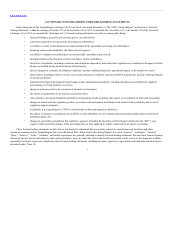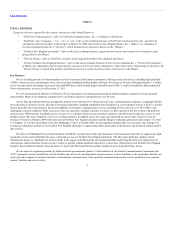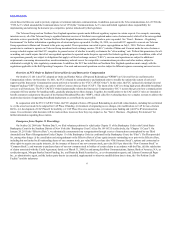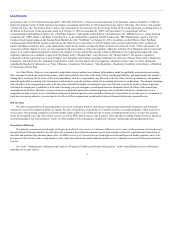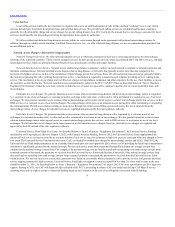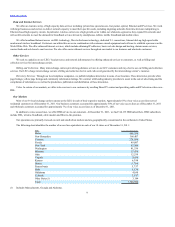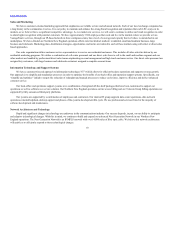FairPoint Communications 2011 Annual Report Download - page 12
Download and view the complete annual report
Please find page 12 of the 2011 FairPoint Communications annual report below. You can navigate through the pages in the report by either clicking on the pages listed below, or by using the keyword search tool below to find specific information within the annual report.
Table of Contents
Our LEC network consists of 95 host central offices and 417 remote central offices, all with advanced digital switches. Approximately 98.0% of our
central offices are served by fiber optic facilities, which we own. The primary interconnection with other incumbent carriers is also fiber optic. Our outside
plant consists of both fiber optic and copper distribution networks.
Our Telecom Group and Next Generation Networks transport systems are a combination of Synchronous Optical Network, Dense Wave Division
Multiplexing, and Ethernet transport capable of satisfying customer demand for high bandwidth transport services. This system supports advanced services
including Carrier Ethernet Services and legacy data products such as Frame Relay and Asynchronous Transfer Mode, facilitating delivery of advanced
services as demand warrants.
In our LEC markets, DSL-enabled access technology has been deployed to provide significant broadband capacity to our customers. As of
December 31, 2011, nearly all of our central offices are capable of providing broadband services through DSL technology, cable modem and/or wireless
broadband.
We face intense competition from a variety of sources for our voice and data services in most of the areas we now serve, and expect that such competition
will continue to intensify in the future. We face competition from many communications providers, including cable operators offering video, data and VoIP
products, wireless carriers, long distance service providers, competitive local exchange carriers, Internet service providers, satellite companies and other
wireline carriers. This competition has had an adverse impact on our access lines, HSD growth rates and revenues.
Regulations and technology change quickly in the communications industry, and these changes have historically had, and are expected to continue in the
future to have, a significant impact on competitive dynamics. For instance, the ubiquity of wireless networks coupled with technology changes, such as VoIP,
and data-driven devices (i.e. computer tablets and netbooks), are creating increased competition and technology substitution, a trend we expect will continue for
the foreseeable future. Public monies in the form of stimulus funds to build broadband networks are also providing a new source of competition for us. In
addition, many of our competitors have access to larger workforces or have substantially greater name-brand recognition and financial, technological and other
resources than we do. Moreover, some of our competitors, including wireline, wireless and cable have formed and may continue to form strategic alliances to
offer bundled services in our service areas.
We estimate that, as of December 31, 2011, most of the customers that we serve have access to voice, network transport and Internet services through a
cable television company. In addition, increasingly, both CLECs and cable companies have begun to penetrate the market for high capacity circuits for large
businesses and carriers, including interexchange and wireless providers. Lastly, in most of our service areas, we face competition from wireless carriers for
voice services.
We use numerous strategies to offset these competitive pressures and changes in customer behavior. Our strategies are focused on maintaining
connections with our customers through enhanced products and services and generating new revenues through new customer growth, win-backs of former
customers and new product development. We offer attractive packages of value-added services that features HSD along with local, long distance calling,
enhanced telephone features and video offerings.
For our business customers, we believe that the reliability and reach of our network is a competitive advantage particularly with regionally based
enterprises in segments like health care and banking. Business customers seek reliable high capacity bandwidth services such as high-level transport services
to wireless cell towers we provide in our territories. We are expanding the number and quality of people selling and servicing our enterprise customers with
sophisticated products and services.
As of December 31, 2011, we employed a total of 3,541 employees, 2,254 of whom were covered by fourteen collective bargaining agreements. As of
December 31, 2011, 72 of our employees were covered by four collective bargaining agreements that expire during the next calendar year.
11




